Sony Zeiss 50mm F14 Review a Mount Ephotozine John Riley
Dwelling house Donate NewSearch Gallery Reviews How-To Books Links Workshops About Contact
Sony 50mm f/1.4
For Sony Blastoff & Minolta MAXXUM
© 2013 KenRockwell.com. All rights reserved.
Intro Specifications FunctioningCompared Recommendations

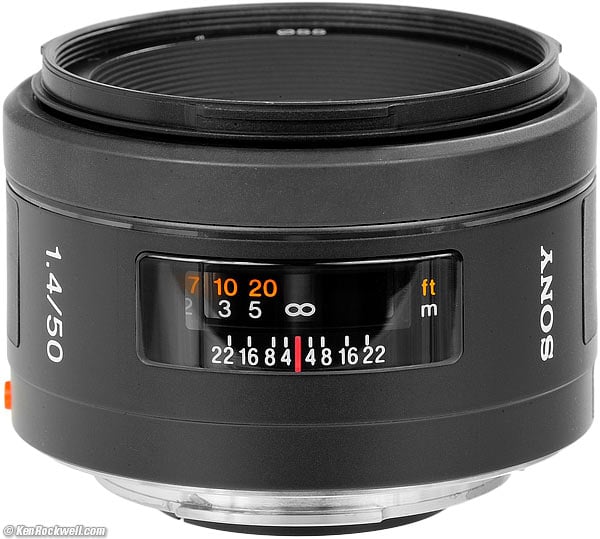
Sony 50mm f/1.four (Full frame, 35mm and smaller-format coverage, 55mm filters, seven.8 oz. /221g, one.v'/0.45m close focus, about $450).
This complimentary website's biggest source of back up is when you use these links, especially this link directly to this lens at Adorama or at Amazon when you get anything, regardless of the land in which y'all live. It helps me keep reviewing these lenses when you get yours through these links — but I receive nothing for my efforts if you purchase elsewhere. Thanks for your back up! Ken.
May 2013 Sony Zeiss Minolta Nikon Canon Fuji LEICA All Reviews
Why Fixed Lenses Take Better Pictures
Introduction tiptop
Intro Specifications PerformanceCompared Recommendations
This is a standard 50mm f/1.4 autofocus lens for Sony Alpha-mountain cameras, which includes every autofocus Minolta MAXXUM or DYNAX, 35mm or digital, on which it works perfectly.
Except for exterior materials and branding, it'south the aforementioned lens as the MAXXUM AF 50mm f/ane.4 introduced past Minolta in 1985 for utilise with the MAXXUM 7000. This current lens with viii rear gold contacts adds distance encoding for better flash exposure accuracy. Other than that, information technology's the same lens optically every bit it was 1985.
Autofocus is via a spiral on the lens, driven by a motor in the camera. As the lens focuses, the focus band turns.
In that location is no instant manual focus override, unless your camera (like the Sony A99) has a DMF ("Direct Manual Focus") override manner. For transmission focus with older cameras yous must move a switch on the camera.
Optically information technology's exactly as expected for a traditional 50mm f/ane.iv SLR lens: softer wide open with plenty of Spherochromatism in the center and coma in the corners, and it improves to near perfection as stopped downwards a stop or ii.
It has moderate barrel distortion, which new cameras like the Sony A99 can right automatically as you lot shoot.
Specifications top
Intro Specifications PerformanceCompared Recommendations
Name meridian
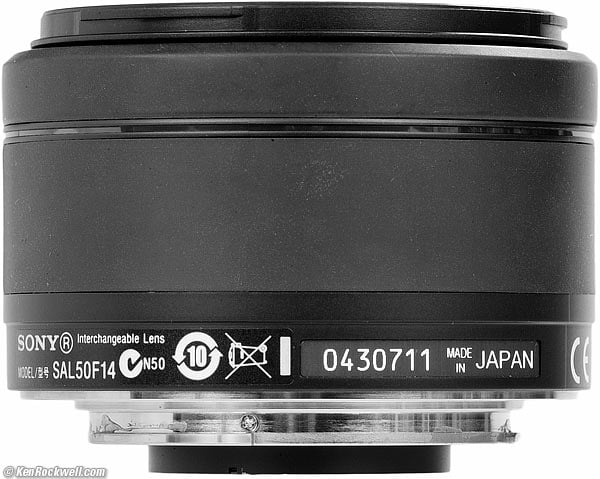
Sony 50mm f/1.iv.
Sony calls this the model number SAL50F14.
Optics top
7 elements in half-dozen groups, standard augmented double-Gauss SLR lens.
Unit focus.
Multicoated.
Diaphragm top
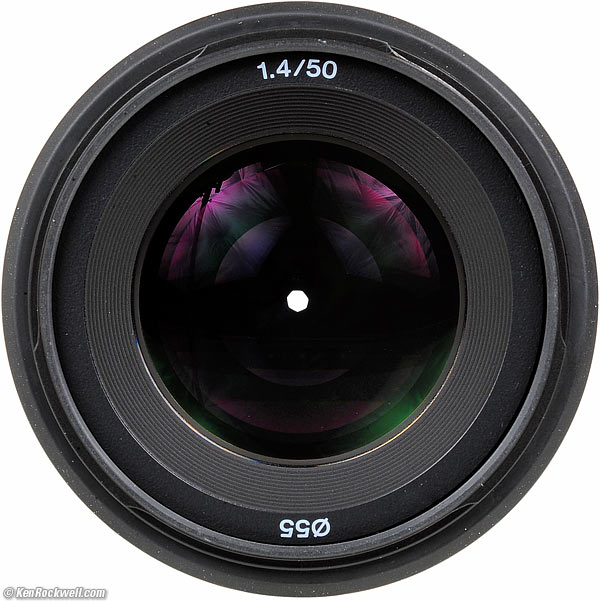
Sony 50mm f/1.4 at f/22.
vii rounded blades.
Round at larger apertures, heptagonal from f/4 and smaller.
Stops down to f/22.
Coverage top
35mm motion picture, total-frame and smaller format digital.
Focal Length top
50mm.
When used on an APS-C style camera, sees an angle of view like to what an 80mm lens sees when used on a total-frame or 35mm camera.
Shut Focus top
1.5 anxiety (0.45 meters) from the prototype airplane.
Maximum Reproduction Ratio elevation
i:6.7 (0.15x).
Difficult Infinity Focus End? elevation
Yes.
This is great for astronomy; just plow to the stop and you have fixed laboratory-perfect focus all night.
Focus Calibration meridian
Yes.
Depth-of-Field Calibration pinnacle
Yes.
Infra-Red Focus Index top
No.
Aperture Ring top
No.
Filter Thread top
55mm, plastic.
Does not rotate, just moves in and out with focus.
Size top
Sony specifies 2-9/16" (65.5 mm) diameter by 1-eleven/sixteen" (43 mm) extension from flange.
Weight top
vii.805 oz. (221.2g), actual measured.
Sony specifies 8 oz. (220 g).
Hood top
Plastic ALC-SH0011 hood, included.
Case top
None.
Included meridian
Caps and hood.
Quality height
Made in Japan.
Warranty top
i year, USA.
Packaging top
Microcorrugated cardboard box with formed pulp innards.
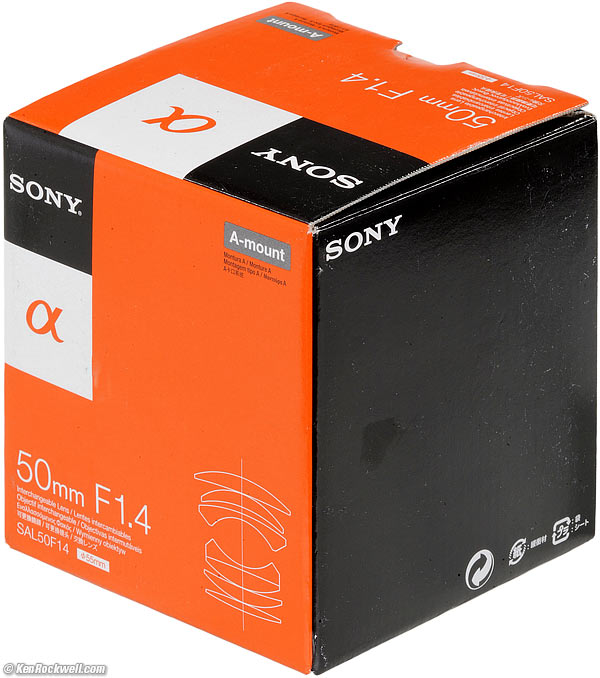
Box, Sony 50mm f/one.iv.
Sony Production Number height
SAL50F14.
Price, USA tiptop
$450, May 2013.
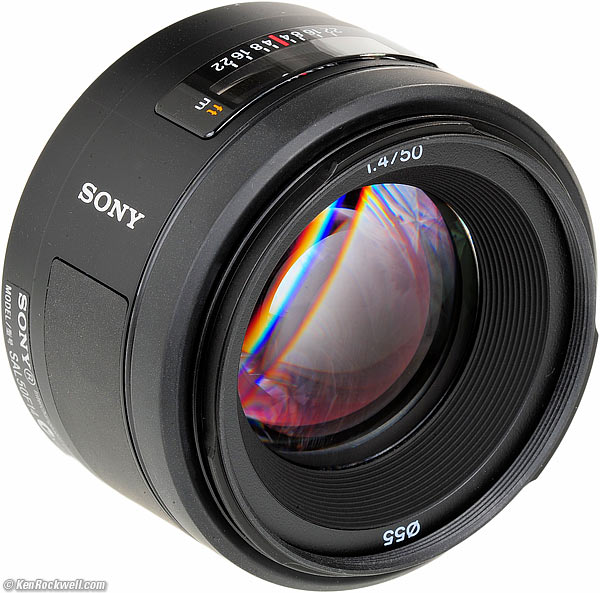
Sony 50mm f/ane.iv.
Operation top
Intro Specifications PerformanceCompared Recommendations
Overall Autofocus Bokeh Coma Distortion Ergonomics
Falloff Filters Focus Breathing Ghosts Hood
Lateral Color Fringes Macro Mechanics Sharpness
Spherochromatism Sunstars Survivability
Overall functioning top
The Sony 50mm f/1.4 is a classic 50mm f/1.4, performing the same as Minolta'southward and Nikon's comparable lenses.
Autofocus performance acme
AF Speed
AF speed is pretty fast, with one full turn (2 half-turns) of the AF screw bringing information technology from infinity down to 5 feet (one.five meters).
AF Accuracy
On the Sony A99, focus is dead-on every time at f/one.iv.
Manual Focus
Manual focus is traditional, and feels pretty plasticy.
Bokeh performance top

Katie'due south cooking show, 15 May 2013. (Sony A99, Sony 50mm f/1.iv, f/4 at 1/lx at Auto ISO 160, Athentech Perfectly Clear plug-in.) bigger.
Bokeh, the character of out of focus backgrounds, not merely how far out of focus they are, is marvelous around f/4.
The Sony A99's programme manner rarely shoots at larger apertures. If I shift information technology the hard way out to f/1.4, bokeh is simply mediocre:
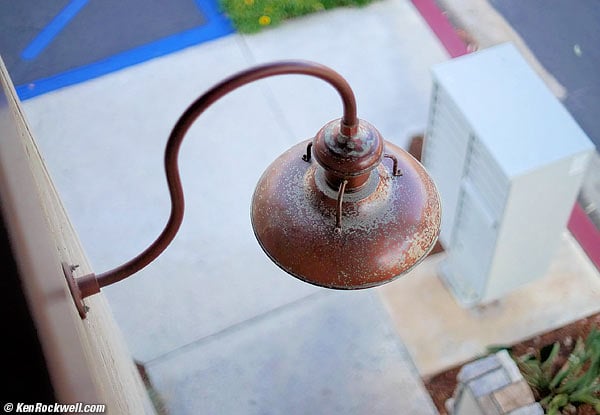
Lamp at f/i.iv. bigger.
Coma performance top
Coma (saggital coma flare) often causes weird smeared blobs to appear around brilliant points of calorie-free in the corners of fast or wide lenses at large apertures.
The Sony 50mm f/1.iv, like other conventional 50mm f/one.four lenses, has loads of coma at f/1.iv and f/ii.
It's pretty much gone at f/2.viii, and completely gone by f/iv.
Baloney functioning peak
The Sony 50mm f/1.four has moderate butt baloney, just slightly more than Nikon'south similar 50mm f/one.four AF-D and Catechism's 50mm f/1.4 USM. It'due south nearly the aforementioned as the much newer Nikon 50mm f/1.4 G.
This can be corrected for critical use past plugging a figure of +2.0 into Photoshop'southward lens distortion filter for use at 3 meters (x feet) on full-frame. These aren't facts or specifications, they are the results of my research that requires hours of photography and calculations on the resulting information.
Used on recent digital cameras similar the Sony Alpha 99, a carte du jour tin be set to correct the distortion completely. Bravo!
Ergonomics (handling and ease-of-use) functioning pinnacle
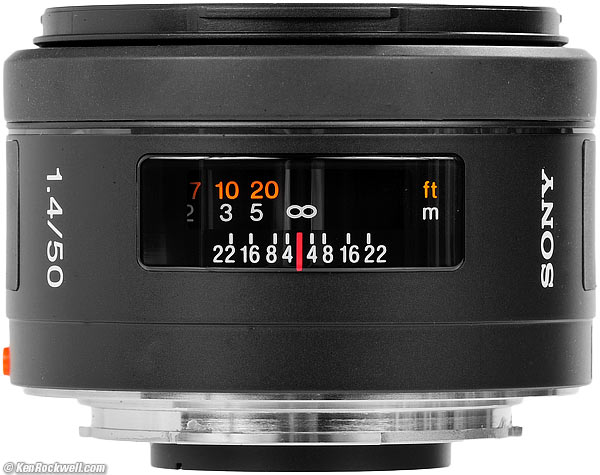
Sony 50mm f/1.four.
Ergonomics are OK, only this lens feels like crappy plastic to me. It's all plastic; the only exterior metal is the mount. Manual focus feels gritty and plasticy.
Used on MAXXUM cameras yous won't accept instant transmission-focus override every bit we do with the newest lenses Nikon (AFS) or Canon (USM), just on the Sony A99, this lens does accept great instant manual-focus override.
This lens, just like Nikon'due south (AF-D) and Canon's (EF not-USM) older-model lenses, requires moving a switch on the camera, or trivial in menus, to bandy between auto and manual focus.
This lens moves its focus band all by itself as it autofocuses.
Other than this, it's like shooting fish in a barrel to mount and unmount; xc% of the barrel is grip.
Information technology doesn't mountain and unmount every bit smoothly as a compatible 1985 Minolta MAXXUM lens mounting on a 1985 MAXXUM 7000, sad to say.
Falloff (darkened corners) performance summit
Falloff on FX and 35mm is visible at f/1.four, and gone otherwise.
The Shading Correction in the Sony A99 improves it a trivial if you lot plough it ON.
I've exaggerated this by shooting a gray field and placing these on a gray background.
Sony 50mm f/1.four falloff on full frame and 35mm at infinity, no correction:
Sony 50mm f/1.iv falloff on total-frame Sony A99 at ISO 100 with Shading Correction ON:
© 2013 KenRockwell.com. All rights reserved.
Filters, utilize with performance top
There is no problem with vignetting, even with combinations of thick stacked filters, even on full-frame.
The filter band doesn't rotate, but it does movement in and out as focused.
Focus Breathing operation meridian
Of interest mostly to cinematographers focusing back and along betwixt two subjects, the paradigm from the Sony 50mm f/one.4 gets larger as focused more closely.
Ghosts performance pinnacle
Ghosts are no problem with this multicoated lens, fifty-fifty on the complex Sony A99 which has all sorts of internal mirrors in the optical shooting path.
Hither's looking straight into the deejay of the noonday sun, which was blinding in person:
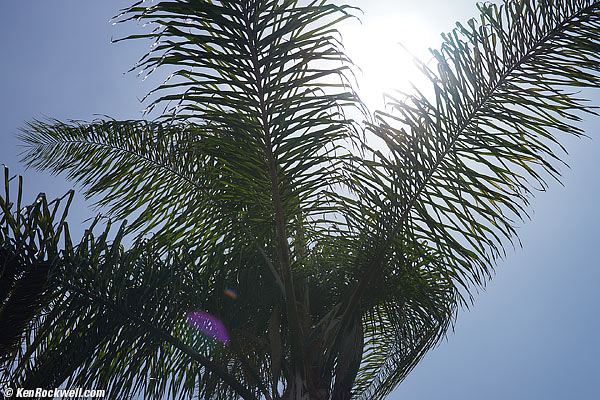
Sony 50mm f/1.iv at f/8. enlarge.
Plenty glare to blind a dead human being, and the worst I could show for it after several tries was one dim blueish blob.
Information technology looked worse through the A99's finder, probably because the A99 views with the lens wide-open. For all I know, the A99 volition catch fire doing this before y'all'll see whatever significant glare.
Hood operation top
The dinky plastic hood is included.
I never use it.
Lateral Colour Fringes operation height
There are no lateral color fringes on the when shot on the 24 MP full-frame Sony A99, with lateral color correction turned OFF.
Oddly, in that location is some very pocket-sized lateral yellowish-blue on the A99 when this correction is turned ON along with shading and distortion correction. I'll presume that the distortion correction somehow isn't quite perfect and interacted with the lateral color corrections. Your photographic camera volition differ.
Macro performance top
It gets exactly every bit close as every other 50mm SLR lens has for the by twoscore years:
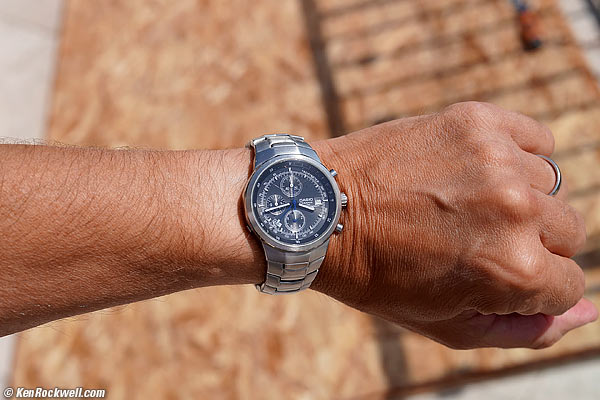
Consummate image at close-focus altitude on total-frame camera.
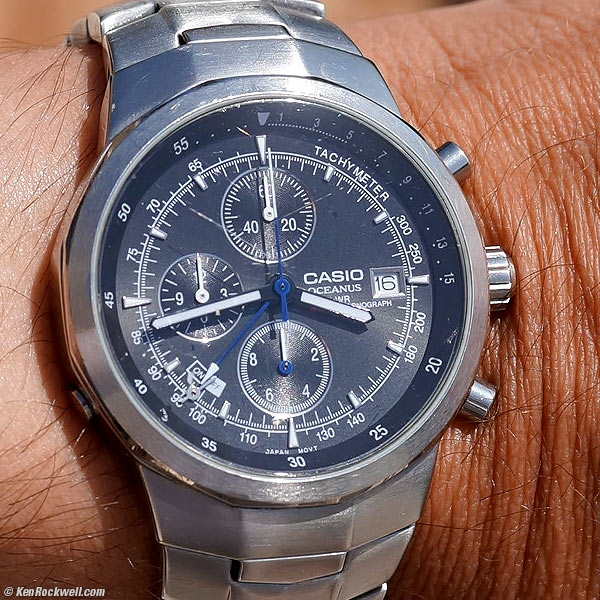
Crop from above epitome at f/8. If this is 6" wide on your screen, the complete prototype printed at this same magnification would exist 18 x 26." (45 x 65 cm.)
Stopped downwards to f/8 equally shown here, information technology'due south super-precipitous, too. Shot at large aperture like f/two, at that place'southward nothing in focus, and if annihilation is, information technology'south not this precipitous.
Mechanics and Construction performance tiptop
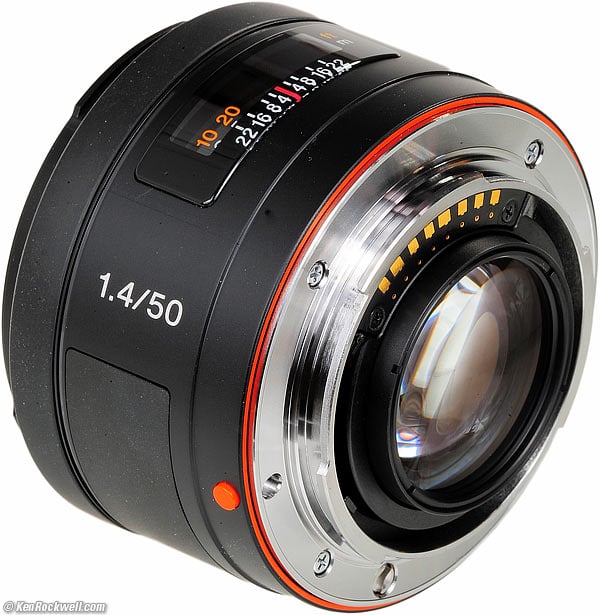
Sony 50mm f/ane.iv. enlarge.
The Sony 50mm f/1.4 is mostly plastic, except for the mount, and information technology feels that way.
Filter Threads
Plastic.
Hood
Plastic bayonet.
Hood Mountain
Plastic.
Butt Exterior
Plastic.
Focus Ring
Plastic; rubber covered.
Focus Helicoids
Feel like plastic, look similar they might be metal.
Depth-of-Field Calibration
Yes.
Aperture Ring
None.
Mount
Chromed metallic.
Markings
Paint.
Mounting Alphabetize Dot
Red plastic nubbin.
Identity Plate
Sticker glued on barrel.
Serial Number
Sticker glued into a recess on the bottom of the lens.
Wet seal at mount
No.
Noises When Shaken
Some clicking.
Made in
Nihon.
Sharpness functioning top

Katie and the billy, 16 May 2013. (Sony A99, Sony 50mm f/1.4, f/viii at 1/250 at Auto ISO 100, Athentech Perfectly Articulate plug-in.) bigger.
Yeah, it's very sharp if you know what you're doing. Image sharpness depends more on y'all than your lens, and lens sharpness doesn't hateful much to adept photographers.
The shot above is actually cropped from a small segment of this frame:

While amateurs waste material time worrying about lens sharpness, pros know that lens sharpness has piffling to do with making precipitous pictures. This said, the Sony 50mm f/1.iv is super-sharp stopped down, and softer at f/1.iv.
As shot on the full-frame 24MP A99:
At f/1.4
The corners are dark and blurrier due to coma (which but matters if they are in focus in the first place), while the center is abrupt enough.
At f/2
The middle is meliorate — nice and abrupt, while the corners are still a fleck blurry, but corner sharpness only matters if they are in focus in the offset place.
At f/ii.8
The corners are much sharper, and the center is just virtually perfect.
At f/4
The center is perfect, and the corners are even better.
At f/5.6
The corners are fifty-fifty a petty bit amend than at f/iv.
At f/8
This is the optimum discontinuity; the corners are at their all-time.
At f/11
Information technology's about the same as at f/8, with the center just slightly dulled from diffraction. (Diffraction isn't as obvious in the corners since they tend to exist softer.)
At f/16
Diffraction limits performance.
At f/22
Diffraction limits performance.
Spherochromatism performance top
Spherochromatism, sometimes mistakenly called "colour bokeh" past laymen, is a modest aberration which tin add slight color fringes to out-of focus highlights.
At f/i.4, the Sony fifty 1.4 shows spherochromatism every bit expected.
Sunstars performance meridian
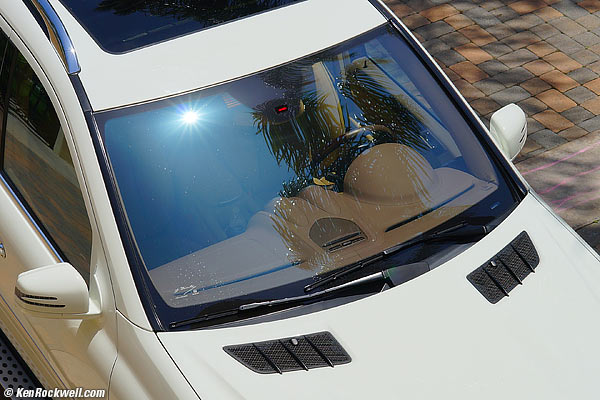
Sunstar at f/8. enlarge.
With its vii-bladed diaphragm that'southward reasonably directly from f/4 and smaller, the Sony 50/i.four tin make great 14-pointed sunstars on vivid points of light. Bravo!
Survivability functioning top
The Sony 50mm f/i.4 may be plastic, simply it has no motors.
If you don't beat out on it mechanically, I wait it will terminal for many decades as take its MAXXUM brethren. The worst I expect will happen with article of clothing is that maybe a focus encoder volition wear out, and if you can't go the part, only clip it out with a pair of dykes.
Compared top
Intro Specifications PerformanceCompared Recommendations
I compared it directly to two different Minolta MAXXUM 50mm f/1.7 lenses from 1985, which sell used for most $75 and pretty much practise exactly the aforementioned thing.
To my surprise, while the f/ane.7 lens has much less distortion, neither of the f/1.seven lenses was as sharp under the microscope as this f/i.4 lens, and the ancient lenses lack altitude encoding for optimum flash exposure accuracy on the newest cameras.
Therefore, I'm sorry to say it, but you may as well get one of these instead of using an quondam MAXXUM lens — only only if you're counitng your pixels wide-open.
Recommendations top
Intro Specifications PerformanceCompared Recommendations
The Sony 50mm f/i.4 feels junky, but works corking, especially with the newest Sony A99 which corrects its distortion and gives this onetime-design lens instant manual-focus override.
I prefer this fast fixed lens to zooms. Midrange zooms are bigger and slower. With this fast and light lens, I can move to get a better shot than standing like an idiot in one identify with a zoom.
In that location are many skillful reasons Why Fixed Lenses Take Better Pictures.
If you've found the time, endeavor and expense I incur researchign and sharing all this data for free, this free website's biggest source of back up is when you use these links, particularly this link directly to this lens at Adorama or at Amazon when you get anything, regardless of the country in which you live. It helps me proceed reviewing these lenses when you lot get yours through these links — but I receive nothing for my efforts if you "scab" and purchase elsewhere. I'm not NPR; I don't get any grants.
Thanks for your back up!
Ken.
Deployment
I'd leave 55mm Hoya HD UV on the lens at all times for protection. I would leave the hood at habitation.
If I was working in nasty, dirty areas, I'd forget the cap, and use an uncoated 55mm Tiffen UV filter instead. Uncoated filters are much easier to make clean, but more decumbent to ghosting.
For color slides (shot on Velvia 50 in a Minolta MAXXUM, for instance), I utilise a 55mm Hoya HMC 81A outdoors.
For B&W moving picture outdoors in daylight, I'd use a 55mm Hoya HMC K2 Xanthous for natural rendition, or I prefer a 55mm Hoya HMC Orange for slightly more than contrast in the skies.
Help me assist you lot top
I support my growing family through this website, as crazy as information technology might seem.
The biggest aid is when you apply any of these links when you get anything, regardless of the state in which you live. Information technology costs you nothing, and is this site's, and thus my family's, biggest source of support. These places have the best prices and service, which is why I've used them since before this website existed. I recommend them all personally.
If y'all find this page as helpful as a book you lot might have had to buy or a workshop you lot may have had to take, feel free to help me continue helping everyone.
If you've gotten your gear through i of my links or helped otherwise, you're family. It's great people like y'all who allow me to keep adding to this site full-time. Thanks!
If yous haven't helped yet, delight do, and consider helping me with a gift of $5.00.
Every bit this page is copyrighted and formally registered, information technology is unlawful to make copies, especially in the class of printouts for personal utilize. If y'all wish to make a printout for personal use, you are granted 1-fourth dimension permission simply if you PayPal me $5.00 per printout or function thereof. Thank you!
Thank you for reading!
Mr. & Mrs. Ken Rockwell, Ryan and Katie.
Abode Donate NewSearch Gallery Reviews How-To Books Links Workshops About Contact
Source: https://www.kenrockwell.com/sony/50mm-f14.htm
0 Response to "Sony Zeiss 50mm F14 Review a Mount Ephotozine John Riley"
Post a Comment